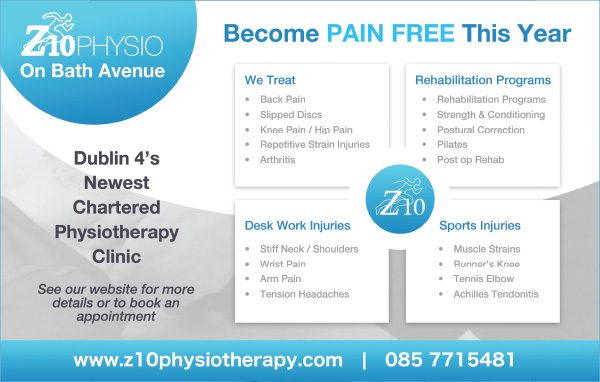Z10physiotherapy courtesy of Paddy O’Rourke

Photograph: Paddy O’Rourke.
Looking after your health is vital. We all know how valuable it is and anyone fighting illness or debilitation, especially, knows how everything else pales in comparison to having good health and mobility.
Back injuries are very common across a wide spectrum of people and ages, as are sports injuries for the active. In this month’s issue Paddy O’Rourke, a local physiotherapist answers some questions on two of the most common complaints to afflict a wide range of people – sciatica and shin splints. Both are very painful and irksome and can be avoided altogether or can be alleviated with good treatment and care.
What is the cure for Sciatica?
Sciatica is the term used to describe pain (and sensation like tingling or numbness) travelling down the back of the leg. In mild cases it can be felt around the buttock and hip and in the more severe cases it can travel into the back of the calf muscle and into the foot. It occurs when the sciatic nerve gets pinched between two vertebrae or in the tight muscles around the hip. The majority of cases will relieve through conservative physiotherapy treatment.
Treatment will include vertebral tractions and mobilizations to free the trapped nerve, massage or dry needling to reduce the muscle spasm, stretches and strengthening exercises to improve stability and mobility around the lower back and pelvis. Improvements are expected after one session.
I have had lower back pain for six months and my MRI scan shows I have two bulging discs and some disc degeneration in my lower back. How can I avoid surgery?
A 2014 study saw that 70% of young, healthy individuals had disc degeneration but no pain. The same study found that over 30% had a disc protruding on a nerve but were fully functional and pain free. This proves that degeneration and disc bulges are part of the normal ageing process.
Pain can come from some inflammation in the area, an irritated nerve, a tight muscle, irritated ligaments or a combination of these. Physiotherapy will work to address these underlying issues through a variety of manual therapy techniques.
Pilates and yoga classes will also reduce pain by strengthening the small muscles that stabilize the spine. Over time, the disc bulges should go away along with a decrease in pain.
How do I get rid of shin splints?
Shin splints can be a very stubborn injury to get rid of. They are extremely prevalent among runners and are also common with people who have flat feet or those who walk a lot in poorly-supported shoes. This excessive movement at the feet can make the shin muscles pull on the inside of the shin bone, causing the area to become inflamed and painful.
Assess your footwear to make sure you have adequate support in the shoes you spend most of your time in. It is also worth getting your feet assessed by a podiatrist as you may need to get an orthotic (insole) for your trainers and shoes. Nowadays, orthotics are no longer bulky and cumbersome. They are very comfortable and can be made for any shoe type.
Stretch your calves, hamstrings and quads every day and do lots of “calf raises” and “dorsiflexion exercise with a band” (find these exercises on YouTube). It these tips do not help, get assessed by a Chartered Physiotherapist to check for other abnormalities.
Paddy works at Z10 Physiotherapy at Bath Avenue Medical Centre. To find out more or to book a session visit www.z10phyiostherapy.com




